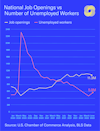Understanding America’s Labor Shortage

We hear every day from our member companies—of every size and industry, across nearly every state—they’re facing unprecedented challenges trying to find enough workers to fill open jobs. Right now, the latest data shows that we have over 10 million job openings in the U.S.—but only around 6 million unemployed workers.
We have a lot of jobs, but not enough workers to fill them. If every unemployed person in the country found a job, we would still have 5 million open jobs.
The U.S. Chamber is capturing the trends on job openings, labor force participation, quit rates, and more, for a quick understanding of the state of the workforce in our America Works Data Center.
Read on for an analysis of the state of the workforce on the national level. For an in-depth look at how the worker shortage is impacting different industries, click here.
How did this happen?
At the height of the pandemic, more than 120,000 businesses temporarily closed, and more than 30 million U.S. workers were unemployed. Since then, job openings have steadily increased since January 2020, while unemployment has slowly declined.
Overall, in 2021, employers ended up adding an unprecedented 3.8 million jobs. But at the same time, millions of Americans have left the labor force since before the pandemic. In fact, we have more than three million fewer Americans participating in the labor force today compared to February of 2020.


Understanding the Gap
Right now, the labor force participation rate is 62.1%, down from 63.3% in February 2020. It’s clear that able workers are being overlooked or sitting on the sidelines. But there’s not just one reason that workers are sitting out, but several factors have come together to cause the ongoing shortage.
The U.S. Chamber surveyed unemployed workers who lost their jobs during the pandemic on what is keeping them from returning to work. Nearly one in three (33%) women indicated that the need to be home and care for children or other family members has made the return to work difficult or impossible. More than a quarter (28%) of men indicated that their industry was still suffering and not enough good jobs were not available to return to work.
In addition to the factors outlined below, the survey also revealed some are still concerned about COVID-19 at work, indicate that pay is too low, or are more focused on acquiring new skills and education before re-entering the job market.
Factors Contributing to the Labor Shortage
An increase in savings
Enhanced unemployment benefits, stimulus checks, and not being able to go out and spend money during the Lockdown all contributed to Americans collectively adding $4 trillion to their savings accounts since early 2020. The extra few hundred dollars a week from enhanced unemployment benefits (which ended in Sept. 2021), specifically, led to 68% of claimants earning more on unemployment than they did while working.
In the Chamber’s survey, 28% of women cited others in the family making enough money that working full-time is not as critical as the reason they have not re-entered the workforce. Just 17% of men said the same. Higher income and savings bolstered people’s economic stability—allowing them to continue sitting out of the labor force.
Early retirements
As of October 2021, the pandemic drove more than 3 million adults into early retirement. In all, the number of adults 55 and older being detached from the labor force due to retirement grew from 48.1% in Q3 of 2019 to 50.3% in Q3 2021.
Lack of access to childcare
Even before the pandemic, a lack of access to high quality, affordable childcare was an issue. Research from the U.S. Chamber of Commerce Foundation found that due to breakdowns in the childcare system, the states surveyed (Alaska, Arkansas, Arizona, Missouri, and Texas) missed an estimated average of $2.7 billion annually for their economies.
A recent report from the U.S. Chamber of Commerce Foundation and The Education Trust shows that the pandemic created a vicious cycle for the industry; to return to work, workers need reliable childcare, but providers are facing immense challenges themselves. The pandemic forced many childcare providers to close or scale down: between February and April 2020, the industry lost 370,600 jobs — 95% of which were held by women. Unfortunately, the recovery has not been swift; as late as September 2021, childcare industry employment remained 10 percent lower than pre-pandemic levels.
Additionally, women are participating in the labor force the lowest rates since the 1970s. In the spring of 2020, 3.5 million mothers left their job, driving the labor force participation rate for working moms from around 70% to 55%. This number is improving – but it has not fully rebounded.
New business starts
In the spirit of entrepreneurship, some employees either left work or stayed unemployed to open their own businesses. Over the last two years, nearly 10 million new business applications were filed and in 2020 alone more than 4 million new business were started.
The Great Reshuffle
Meanwhile, there has been a “Great Reshuffle” among workers. ‘The Great Resignation’ worked its way into our vocabulary as the shift of our labor force started to become apparent—and the hashtag #quittok even went viral as social media users posted about quitting their jobs in search for more free time or better opportunities.
A full 4.4 million people quit their jobs in May 2022, but hiring has outpaced quits since November 2020 (hovering around 4.4%).

These reasons above help illuminate the current labor shortage landscape, but the examples are non- exhaustive.
Understanding why workers are missing from unfilled jobs is only half of the equation. The next step in addressing the labor shortage is to implement solutions to attract and retain new workers is underway. Learn about how the U.S. Chamber is driving solutions through the America Works initiative here.



